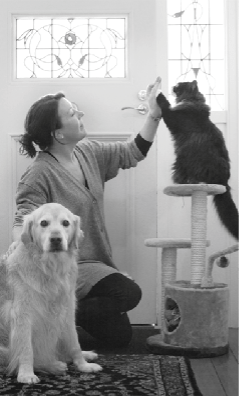Bringing home another friend and welcoming it to your family is an exciting time for everyone, but if you have other pets you may be finding yourself mediating over nasty personality conflicts. Some new cats will be fearful, others pushy, and how your existing pets will react is quite unpredictable.
This article should give you a few helpful tips to ensure a happy start.
- Make sure you have a safe carrier box for transport.
- Prepare your house. Your new cat needs to be provided with a room or area of the house away from the other pets initially. Remember to keep the area safe: put toilet seats down, tie loose cords up and remove fragile items. Provide all the essentials; a cosy bed, litter tray, toys, food and water. Make sure this place is a “neutral zone” such as an office or laundry, not a place where your existing pets like to spend time. Your existing pets should still have access to their usual places (such as the favourite sleeping chair or window sill).
- Spend time with your new cat. Make sure you’ve enough time to gently play and interact with them, without upsetting the routines of your existing pets.
- Start just with exchanging smells between pets, by alternately stroking your pets, swapping bedding and placing a towel that has been rubbed over the new pet under your existing pets food bowl (and vice versa).
- At a calm time of the day, preferably when there is someone else to help you, after spending 10 minutes or so with your new cat, and after exercising/playing with your pre-existing cats or dog, it is time for the introduction. This can be done a variety of ways and really depends on the players. Most adult cats are fairly tolerant of kittens and can be introduced when they are eating or playing, providing there is plenty of space between them. However, harnesses, leashes, baby gates and even cages maybe needed and can be extremely helpful to prevent injuries and chases. If using a cage to house your new cat, place it up on a bench to prevent challenging eye balling and to make your new cat feel safer.This allows your existing pets to exchange smells and observe body postures. Keep introductions brief (5 minute sessions several times a day is much better than a long stressful encounter). Keep your pets calm and build positive emotions by stroking, talking and feeding.
Reward good behaviour and don’t tell them it’s OK if there is any hissing or snarling, just separate them again, and reattempt later when everyone is calm again.
- Gradually feeding and petting in the same room can take place without these devices as they learn to associate good things with each other’s presence. This is called classical conditioning and requires patience and repetition for success. Watch signals really closely. Subtle signs from cats include the direct stare, a raised bottom and tail, and sometimes hair-raising. Subtle signs from dogs include hair raising, staring, snarling, lip lifting and stalking. If you are seeing these signals, they are not ready to be unsupervised. We want your existing pets to feel excited and happy to share their space with the newcomer.

- The breed of dog you have, and the cat’s previous experiences will greatly influence the ease of introduction. Introducing a feisty terrier and a cat that has never seen a dog before, will provide a great challenge! Your dog might need to learn to “stay” or “leave it”, or may need to be kept on a lead at all times initially. Muzzles might even be needed. Keep yourself safe! Never put your hands or legs between fighting pets. Use a broom, blanket, cardboard or awater pistol and separate them to neutral zones. Obviously if this is the case, seek professional advice.
- When calm behaviour and friendly exchanges are taking place, your pets can probably be left unsupervised and your new cat can have free access to the house. This could take hours to weeks. Ideally, cats should be able to move around the room and access other rooms without touching the floor.
Cat trees, shelves and furniture can be arranged to provide these escape routes. Then your cat can decide if it wants to share space with your pets or not.
- Remove competition between pets. Fighting over access to valued things such as sleeping areas, human attention and food is the most common cause for poor relationships. Keep routine times for one-on-one play so no one feels left out. Cats like to have their own retreats, up high, where they can sleep or observe the world and hide when afraid. They organise their territories with certain areas being dedicated to certain activities (an eating area, playing area, toilet etc). They also need to mark and scratch to communicate where these areas are. (Feliway®, and a scratching post near these sleeping and eating areas will save the carpet). A litter tray needs to be safe from dogs and children, in an easy access area. If you already have a cat, they need a litter tray each, plus one spare, to reduce competition. Hunting areas need to be established as well. This is where your cat will play so it needs to be well enriched with toys and gymnastic opportunities (to avoid human legs from becoming the prey!)
- Remember that different pets require different things. Kittens need 12 hours’ sleep (not all in one stretch) for brain development, and will be very playful when they awake, ready to chase anything. Supervise children and avoid play that leads to overexcitement or biting, or the kitten may never develop self control. Similarly older cats have their own particular requirements. Your new cat’s habits and likes may be completely different to those of your existing cat.
- Be patient and observant. It’s easiest to let your pets set their own pace and not to force contact between them as they set up their social system.
- Sometimes cats are content to just share their space with another, but won’t actually become the close friends you may be hoping them to be. Don’t worry; you haven’t picked an “antisocial” one. Normal social cat units consist of the family; that is the queen and her offspring (of many generations). Having to share space with unrelated cats or other species can be a rather threatening situation! The good news is that with the right attention, most cats will make themselves truly “at home” with the rest of your menagerie!

| animal behaviour Dr Katrina Ward |




